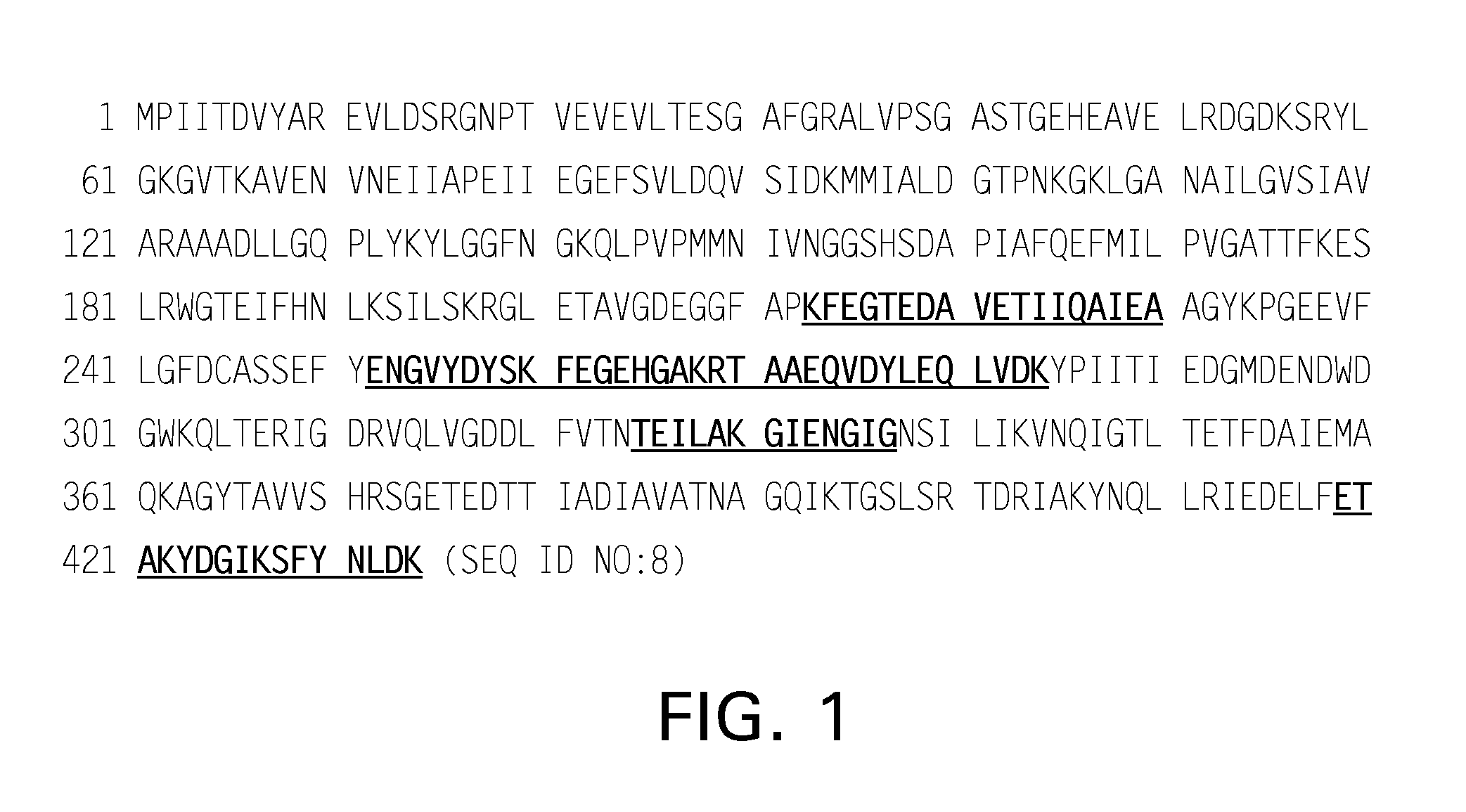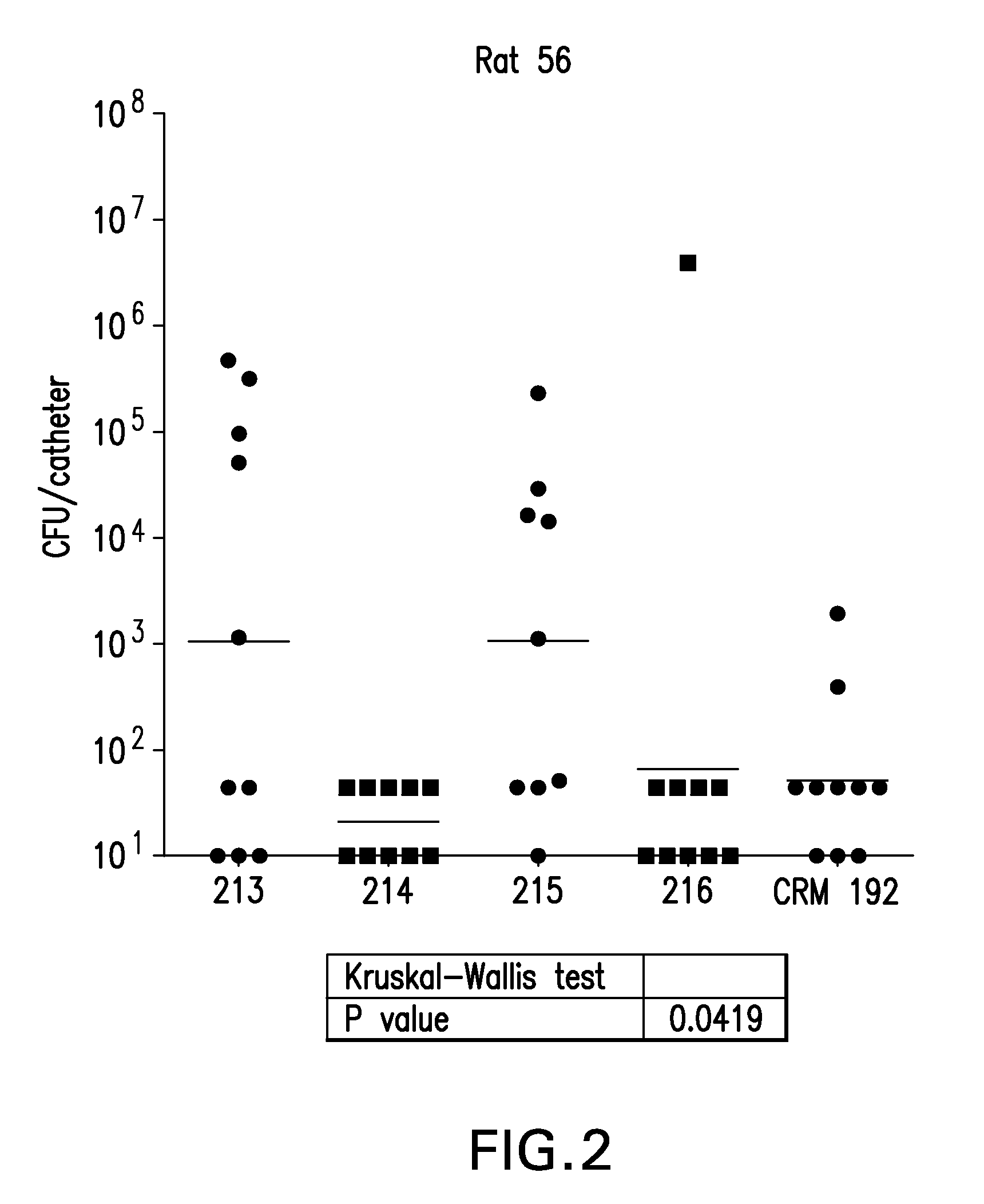Enolase peptide conjugate vaccines against Staphylococcus aureus
a technology of enolase and conjugate vaccines, which is applied in the direction of peptide/protein ingredients, lyases, antibody medical ingredients, etc., can solve the problems of insufficient support of the usefulness of most antigens as vaccine candidates, increased seriousness, and failure of most to provide protective immunity
- Summary
- Abstract
- Description
- Claims
- Application Information
AI Technical Summary
Benefits of technology
Problems solved by technology
Method used
Image
Examples
example 1
Peptide Synthesis and Conjugation
[0211]Peptides were synthesized by microwave chemistry on a liberty synthesizer on NovaPEG Rink amide resin at 0.15 mmol scale. Alternatively, peptides were synthesized by microwave chemistry using ChemMatrix amide resin at 0.15 mmol scale.
Conjugation to Biotin.
[0212]Peptides were purified and conjugated to biotin to be used to determine antibody ELISA titers in sera generated from immunization of animals with the peptides conjugated to carrier proteins. For example, the peptide of SEQ ID NO:1 gave:
[0213]
Ac-KFEGTEDAVETIIQAIEA-Aha-Cys(PEG2-Biotin)-NH2Yield: 3.86 mg. Purity was >95%.
And the peptide of SEQ ID NO: 2 gave:
[0214]
Ac-ETAKYDGIKSFYNLDK-Aha-Cys(PEG2-Biotin)-NH2Yield: 5.27 mg. Purity was >95%.
Conjugation to Carrier Protein.
[0215]Peptides containing terminal cysteine residues for conjugation were purified following solid phase synthesis and reacted with maleimide activated CRM. CRM was maleimide-activated on surface-accessible lysine residues by ...
example 2
Formulation
[0217]The Enolase peptide CRM197 conjugates were formulated along with the CRM and Sdre controls in Merck Alum, an aluminum hydroxyphosphate sulfate adjuvant, at 0.15 mg / ml, i.e. peptide SEQ ID NO: 1, peptide SEQ ID NO: 2, peptide SEQ ID NO:5, peptide SEQ ID NO:6 and CRM.
example 3
Murine Lethal Challenge Model
[0218]Female Balb / c mice (6-9 wks of age, 20 animals per group) were immunized 3× intramuscularly with 20 ng of CRM (negative control), SdrE (control) or Enolase peptides conjugated to CRM 197 on days 1, 7 and 21. Mice were challenged with a lethal dose (6.0×108 CFU) of S. aureus Becker (strain provided by Chia Lee, University of Arkansas for Medical Sciences, Little Rock); grown in TSA (tryptone soy agar; Becton Dickinson, San Jose, Calif.) on day 35 and survival was monitored over a 10 day period.
[0219]
TABLE 3Survival data for 10 days post challenge with Peptide - CRM ConjugatesImmunogenSurvival No.% SurvivalSdrE Control08 / 2040Enolase #214 (SEQ ID NO: 1)09 / 2045Enolase #215 (SEQ ID NO: 2)06 / 2030CRM Control02 / 2010*P value 0.0221
[0220]Data obtained shows survival was enhanced in mice immunized with Enolase peptides versus the negative control antigen CRM, which was significant protection p=0.0221. See Table 3.
[0221]Mice were bled before immunization and a...
PUM
| Property | Measurement | Unit |
|---|---|---|
| stability | aaaaa | aaaaa |
| size | aaaaa | aaaaa |
| resistance | aaaaa | aaaaa |
Abstract
Description
Claims
Application Information
 Login to View More
Login to View More - R&D
- Intellectual Property
- Life Sciences
- Materials
- Tech Scout
- Unparalleled Data Quality
- Higher Quality Content
- 60% Fewer Hallucinations
Browse by: Latest US Patents, China's latest patents, Technical Efficacy Thesaurus, Application Domain, Technology Topic, Popular Technical Reports.
© 2025 PatSnap. All rights reserved.Legal|Privacy policy|Modern Slavery Act Transparency Statement|Sitemap|About US| Contact US: help@patsnap.com



